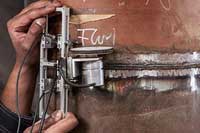Test Pressures
The selected test method and fluid test medium, together with the applicable code, will also establish the rules to be followed in calculating the required test pressure. In most cases a pressure greater than the design pressure rating is applied for a short duration, say at least 10 minutes. The magnitude of this initial test pressure is often at least 1.5 times the design pressure rating for a hydrostatic test. However, it may be different, depending upon which code is applicable and whether the test is hydrostatic or pneumatic.
Furthermore, the test pressure must never exceed a pressure that would cause yielding, or the maximum allowable test pressure of some component exposed to the test. In the case of ASME B31, section 137.1.4, and the Boiler and Pressure Vessel Codes, the maximum test pressure must not exceed 90 percent of yield for any component exposed to the test. The test pressure is needed to demonstrate that the system can safely withstand the rated pressure. Following this period of greater than design pressure, it is often permissible to reduce the pressure to a lower value for examination of leaks. The examination pressure is maintained for the length of time necessary to conduct a thorough
asme b36.10, bundle, weldolet, lap joint, shielded metal arc welding, mss sp43, corner joint, wpq, butt joint, rockwell, astm a105, A106, a182, a194, edge joint, welded pipe, alloy steel, tube bending, butt weld, weld neck, threaded joint, welding performance qualification, stub-in, tee crosses, swing check valve, o'let, dye penetrant inspection, hot bolting, storage tanks, stainless steel, spiral wound, reducing o'let, spiral welding, pressure class, stub-on, spherical pressure vessel, seal weld, asme b31.2, b34.4, b31.5, b31.8, b31.9, b31.11, socket weld fitting, aluminium, slurry, extended spindle, carburizing, pressure class, slip-on flange, single random pipe length, maximum allowable span, mpi, segmental bore, branch connection, seat(s), magnetic particle inspection, safety valve, asme b31.3, reducing o'let, asme a312, pipeline pigging, reducing elbow, pump, plant north, true north, petro-chemical, seamless pipe, ultrasonic, pinch valve, drip leg, smaw, reduced port, astm a216, structure, a217, a234, 312, gtaw, branch table, shut-off valve, nps and schedule, vacuum box, welding procedure qualification record, vickers, lpi, nipolet, worlds largest valves, api spec 6a, metalic ring, anchor, liquid penetrant inspection, welding procedure specification, mannesmann, brinell, filled weld, carbon steel, crude oil storage tank, chain wheel, expansion joint, asme b16.48, MSS-SP-58, hot tap, MSS-SP-69, b16.34, b16.25, sandvik, ips and schedule, electric resistance welding, lap joint flange, explosion welding, globe valve, full port, gland, fuel gas hoses, gate valve, lokring, dynamically loaded, sockolet, full face gasket, longitudinally welding, forging, elastomeric gasket, dynamic seals, astm a530, a420, a403, a352, non-destructive examination, diverter valve, tig welding, asme boiler and pressure vessel code bpvc, asme a182, nde, distillation column, rt, needle valve, wpqr, disc, radiographic, column, non return valve, haz, flat face, nrv, camprofile gasket, api, trunnion, mss, barrel, reinforcing pad, eddy current, asme B36.10, backflow, killed carbon steel, astm 351, eddy current testing, grade cf8c, eccentric reducer, asme b36.10, din flanges, wps, weep hole, rigid support, asme b36.19, metal seated, butterfly, npt, asme b31.3, ball valve, quadrant edge, square edge bore, largest bolts, a335 gr p12, asme b31.1, glycerin, constantly loaded, discharge, gmaw, pressure gauge, pipeline pigging, mig welding, asme b16.47, stub end, charpy impact, oil and grease, asme b16.20, laser welding, graphite pads, a234 gr wp9, penetrant, asme b16.11, check valve, orbital, asme 16.21, api 600, a182 gr f22, asme b16.5, electrode, floating head, iris, nominal pipe size, asme B16.36, b16.47, thermowell, variable spring support, pressure testing

